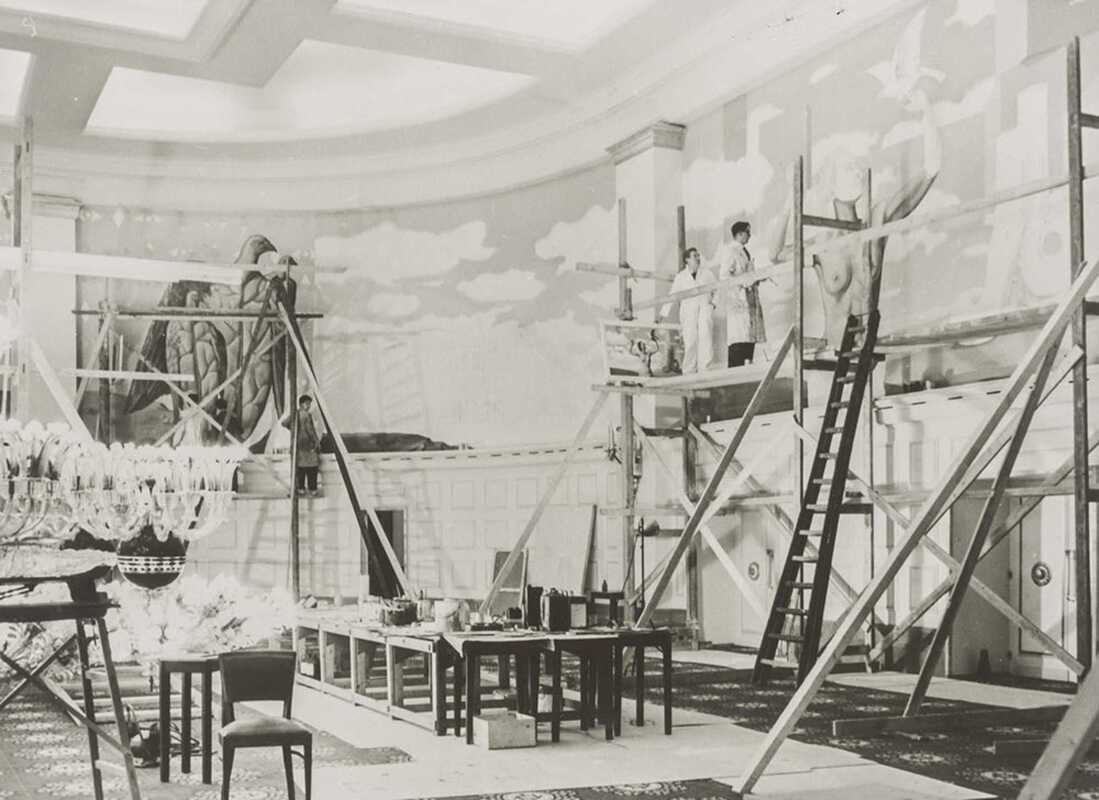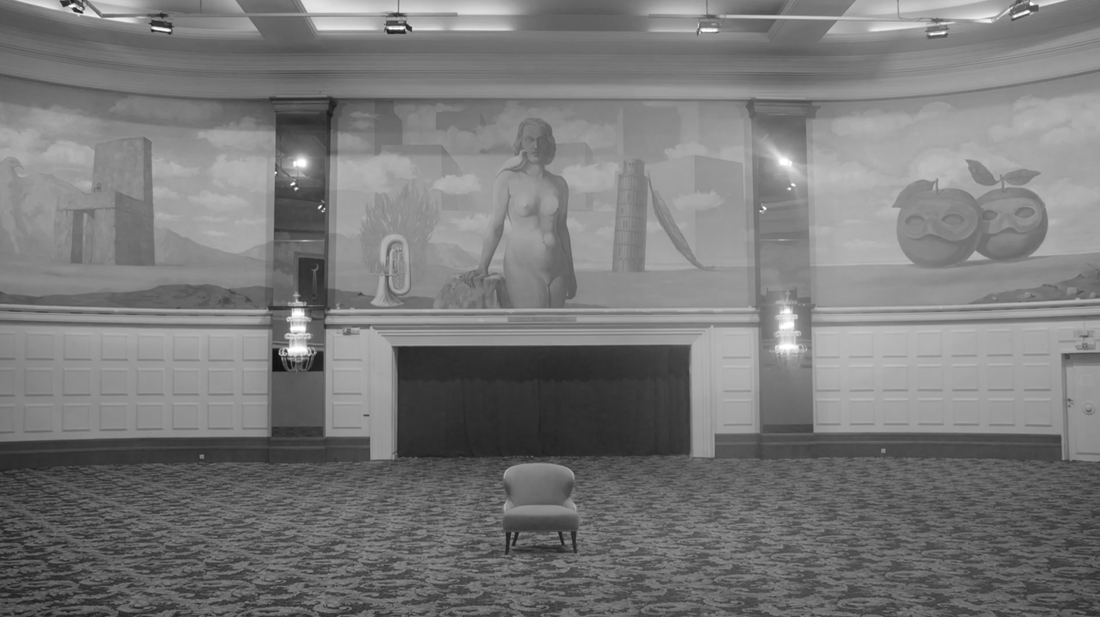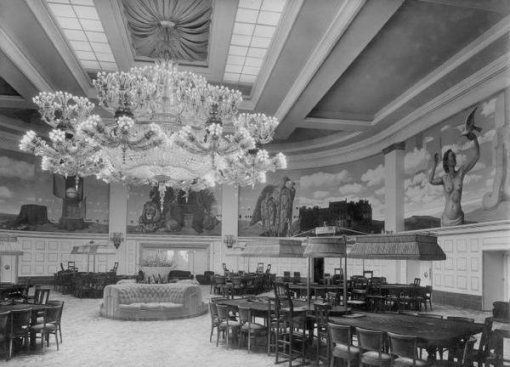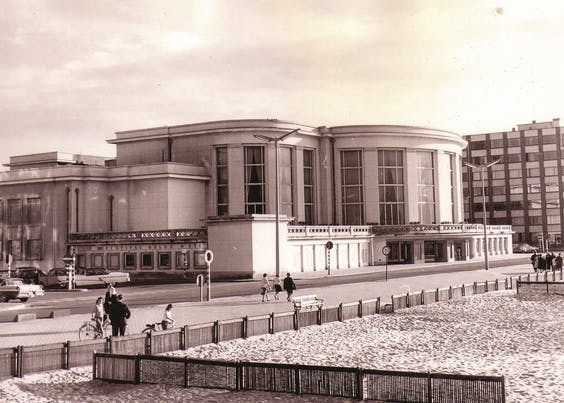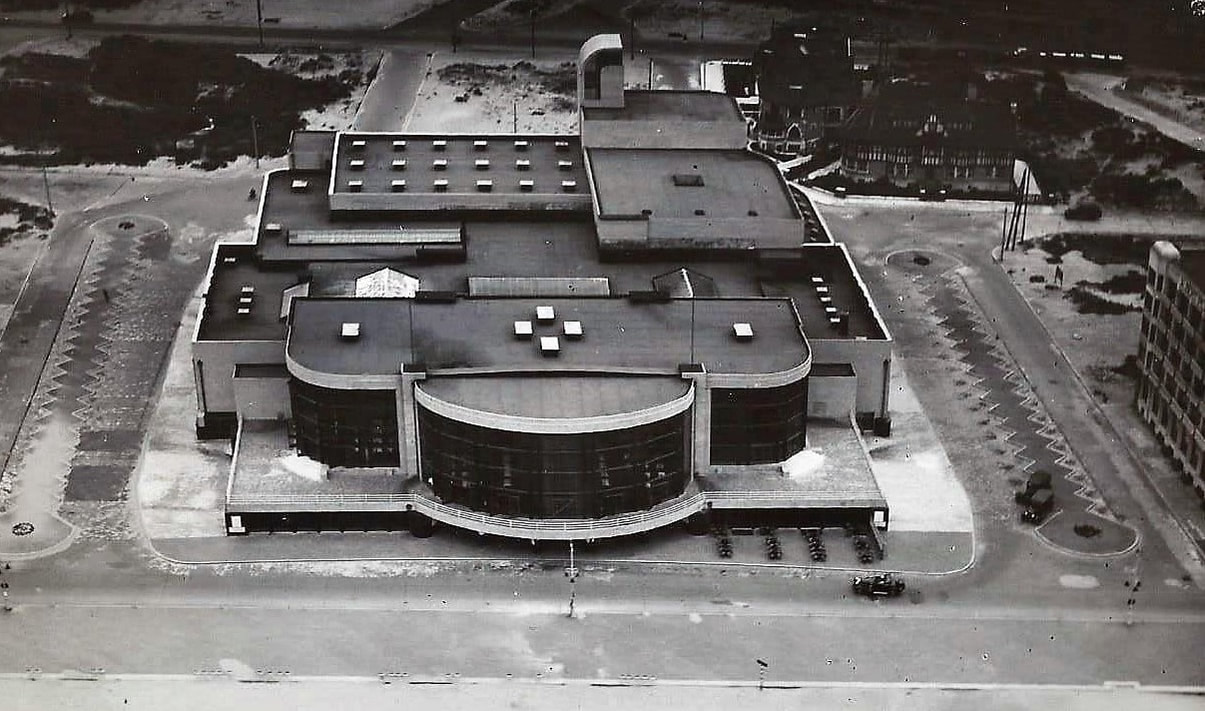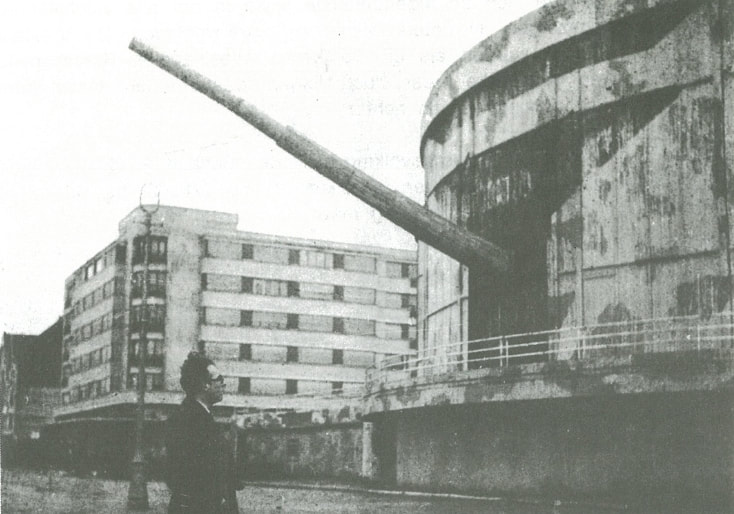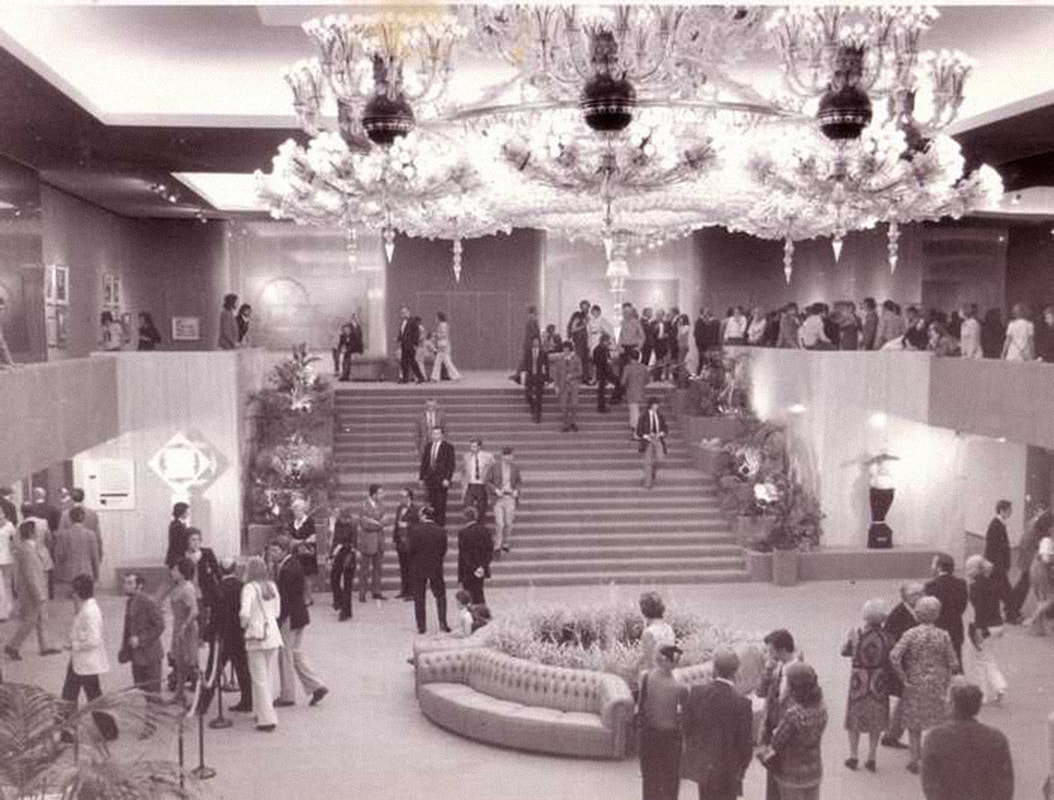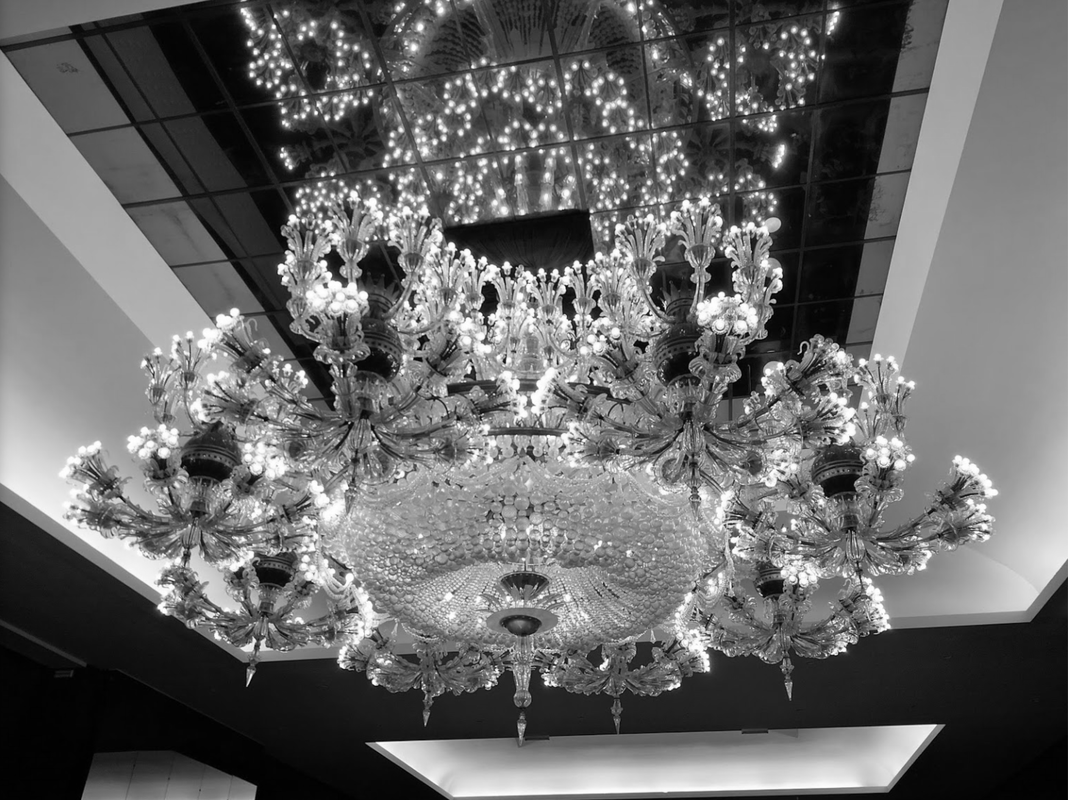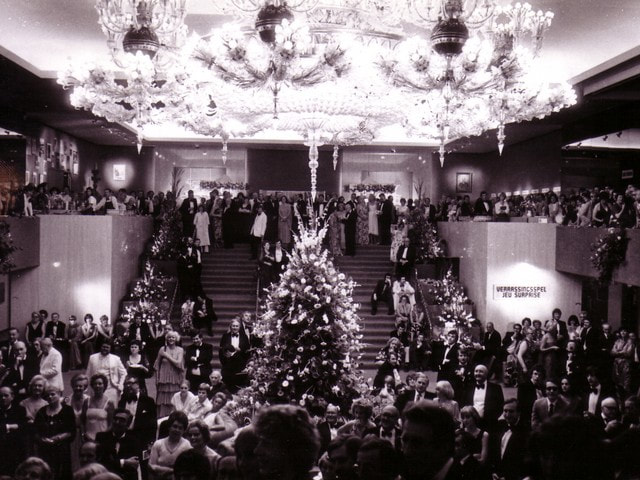Een iconische verborgen cultuurtempel met een rijke geschiedenis.
Fascinerend is de blik in de ogen van menig oudere kunstliefhebbers als men spreekt over het Casino van Knokke. Bijna de helft van de verzamelaars in HIGHLIGHTS.be heeft Keith Haring nog aan het werk gezien in zijn eigen zaal op de eerste verdieping.
Sommigen herinneren nog de aangename momenten met de familie Nellens thuis tijdens de “Déjeuners sur l’herbe” rond “Le Dragon” de mythische creatie van Niki de Saint Phalle die nog steeds in de tuin schittert van wijlen Roger Nellens. Gustave, Jacques en Roger Nellens zullen net als Leopold Lippens altijd herinnerd worden als dé families die Knokke-Heist op de internationale kaart hebben gezet in de 20e eeuw.
De laatste maanden hebben we helaas afscheid moeten nemen van de laatste telgen waarmee een generatie werd afgesloten. En toch, terwijl de Keith Haring en de Paul Delvaux in de tijd van een vorige uitbater helaas verdwenen zijn, blijft de iconische kroonluchter en de fameuze Magrittezaal tot de verbeelding spreken bij menig liefhebber van wat mooi is.
Het was meer dan 90 jaar geleden, in de jaren ’30, dat alles begon met de grote bouwwerven van de zeedijk en de constructie van het Casino. Al van in den beginne was het opzet om de meest gerenommeerde kunstenaars uit alle uithoeken van de wereld te lokken naar het Casino van Knokke en het later bijhorende Hotel La Réserve.
Uiteindelijk waren het de jaren ’50 & ’60 die tot de absolutie gloriejaren mogen worden aanschouwd. Het was ook de familie Nellens die destijds betrokken was bij de heraanleg van de zeedijk in de jaren ’20. De familie was toen eigenaar van iets meer dan 200 hectare in Knokke. Het was Joseph Nellens die in 1928 na een architectuurwedstrijd, de opdracht toevertrouwde aan Léon Stynen.Toen amper 30 jaar pootte deze een gebouw neer die zo iconisch was dat deze hem nadien de opdracht bezorgde om ook het Casino van Blankenberge, Chaudfontaine en Oostende te ontwerpen. Uiteindelijk verwierf hij de meeste beroemdheid met het BP- gebouw en de Singel in Antwerpen. Hij was leerling en vriend van Le Corbusier, die trouwens ook dit jaar wordt geëerd in de Collectors Lounge van HIGHLIGHTS.be in de Magrittezaal.
Maar het was Gustave Nellens, de zoon van Joseph die eigenlijk de meeste strepen verdient in de uitbouw van de internationale faam van het Casino. De oudste generatie herinnert zich nog de legendarische “Thé dansants”, avondkleding was altijd vereist en de artiesten waren van wereldformaat. Denk maar aan Edith Piaf, Joséphine Baker, Ray Ventura, Richard Tauber,... Slechts 6 jaar na haar opening breekt de 2e Wereldoorlog uit, het gebouw werd als ontspanningsruimte gebruikt door de Wehrmacht en het Casino was omgebouwd tot burcht, als onderdeel van de Atlantikwall met een gigantisch kanon dat uit de gevel dreigde, welke achteraf slechts een afschrikking blijkt te zijn. Op het einde van WOII bleek het Casino zeer zwaar beschadigd.Veerkrachtig als de Belgen zijn wordt de periode na de oorlog uiteindelijk het absolute hoogtepunt van het Casino, wanneer in 1949 paviljoen Zegemeer omgedoopt wordt tot Hotel La Réserve. Het was in Hotel La Réserve dat de traditie van de kunstbeurs in Knokke trouwens 47 jaar geleden ontstond, om uiteindelijk pas na 45 jaar in het Casino te belanden.
De lijst van internationale topartiesten in het Casino wordt nu stilaan eindeloos, Frank Sinatra, Marlene Dietrich, Nat King Cole, Ray Charles, Ella Fitzgerald, Jacques Brel,... Zoals iedereen weet zijn Jacques Brel en het Casino van Knokke uiteindelijk samen beroemdheid gaan verwer ven, dittot in New York. Zo zijn er de interviews die hij gaf in Knokke, de opnames van zijn eerste film en de reflectie naar het Casino en de Noordzee in zijn befaamde repertoire.
De creativiteit van Nellens blijkt werkelijk verbluffend en uit zich in allerlei festiviteiten en festivals in het thema van muziek, film, theater en kunst. De kunstexpo’s blijven bij tot vandaag: Pablo Picasso in 1950, Raoul Dufy in 1954, Salvador Dali in 1956, Bernard Buffet in 1959, Felix Labisse in 1960, Marc Chagall in 1961, René Magritte in 1962, Balthus in 1966, Joan Miró in 1971,...
Tegelijkertijd zet het Casino in op het ontdekken van jong talent waarbij namen werden ontdekt zoals Panamarenko, Robert Rauschenberg, Andy Warhol,... Het was in 1952 dat de, op dat moment grootste kroonluchter ter wereld, haar intrede deed in de Rotondezaal. Nadien verhuisde ze naar wat nu de Kroonluchterhal heet, we spreken over 8,5m diameter, 7,5m hoog, 2.000 lampjes, een gewicht van 7 ton en meer dan 20.000 stukjes Venetiaans kristal. De verhuis van de kroonluchter was te wijten aan de ombouw van de rotondezaal naar de Magrittezaal, toen René Magritte een wedstrijd won de (toen kleine speel)zaal in te richten met zijn 72 meter lange muurschildering “Het Betoverde Domein”, welke uiteindelijk 60 jaar later beschermd erfgoed werd. Niet alles liep van een leien dakje, zo was Magritte zelf niet welkom op de opening toen bleek dat zijn atelier sterk betrokken was in de uitwerking en Nellens stelde dat hij zijn leveranciers niet uitnodigde op openingsrecepties.
In de jaren ’60 begon het wintertoerisme op te komen en ging het Casino voor het eerst ook open buiten de zomer wat extra verbouwingen met zich meebracht. Het plotse overlijden van Gustave Nellens werd door zijn vrienden geëerd met het beeld “Eva” van Eugène Dodeigne welke tot op heden nog steeds voor het Casino zijn plaats in ere houdt. Uiteindelijk waren het zoon Jacques en diens broer Roger, die zelf ook kunstenaar was, die het beheer overnamen van het Casino. In 1983 werd het schilderij “De Legendarische Reis” geplaatst boven de linker traphal in de kroonluchterhal. Het werk was gemaakt door Paul Delvaux in 1974 voor het Casino van Chaudfontaine, wanneer hun concessie werd opgezegd door de stad, verhuisde het doek naar Knokke.Verder werd de zaal opgesmukt met schilderijen van Roger Nellens zelf en van Niki de Saint Phalle. In 1987 was het de New Yorkse kunstenaar Keith Haring die een muurschildering maakte, die kaderde in zijn expo maar uiteindelijk bleef hangen. Tijdens zijn verblijf sliep Keith Haring in “Le Dragon” het tuinhuis van de familie Nellens, welke gemaakt was door Niki de Saint Phalle. Maar de tijden veranderen en in de jaren ’90 droeg de familie Nellens de concessie over aan de Franse groep Partouche.
Het culturele en muzikale programma werd beëindigd en gedurende decennia werd het Casino gebanaliseerd tot een speelhal met sporadische banketten en recepties. Na Partouche kwam het Casino in het beheer van Napoleon Games. Hier was er duidelijk wel de ambitie om opnieuw in te zetten op kwaliteit en zo werd de speelzaal volledig vernieuwd en werd ook het restaurant Mascotte opgefrist. In 2021 maakte Alexander Tuteleers zijn intrede met opnieuw een culturele manifestatie in het Casino van Knokke. Om de reflectie te maken met de nog aanwezige geschiedenis werd het eerste project een eerbetoon aan René Magritte.
Het was de kunstenaar Jan De Cock die werd geselecteerd om een “Gesammtwerkstatt” te maken. Na een lange tijd van isolement, die de covid-crisis met zich had meegebracht, bouwde de kunstenaar een atelier in de Magrittezaal waar het proces van zijn bronzen Burgers van Calais kon worden gevolgd in interactie met de surrealistische wereld van René Magritte. Jan De Cock is de enige levende Belgische kunstenaar die een solo expo heeft gehad in MoMa NewYork,Tate Modern Londen en Bozar te Brussel.
In 2022 vindt de eerste HIGHLIGHTS.be plaats welke een bewijs levert van de traditie van het kunstverzamelen die Vlaanderen samen met Noord-Italië al sedert de middeleeuwen op de kaart plaatst. De expo staat voor een reis door de tijd die letterlijk in het Casino begint, welke de sfeer van de 20e eeuw uitademt, en gaat verder naar de toekomst met iconische werken die Modern worden na hun Hedendaags bestaan om ooit te vereeuwigen tot het antiek van morgen. Net als de geschiedenis en de toekomst van het Grand Casino Knokke.
Fascinerend is de blik in de ogen van menig oudere kunstliefhebbers als men spreekt over het Casino van Knokke. Bijna de helft van de verzamelaars in HIGHLIGHTS.be heeft Keith Haring nog aan het werk gezien in zijn eigen zaal op de eerste verdieping.
Sommigen herinneren nog de aangename momenten met de familie Nellens thuis tijdens de “Déjeuners sur l’herbe” rond “Le Dragon” de mythische creatie van Niki de Saint Phalle die nog steeds in de tuin schittert van wijlen Roger Nellens. Gustave, Jacques en Roger Nellens zullen net als Leopold Lippens altijd herinnerd worden als dé families die Knokke-Heist op de internationale kaart hebben gezet in de 20e eeuw.
De laatste maanden hebben we helaas afscheid moeten nemen van de laatste telgen waarmee een generatie werd afgesloten. En toch, terwijl de Keith Haring en de Paul Delvaux in de tijd van een vorige uitbater helaas verdwenen zijn, blijft de iconische kroonluchter en de fameuze Magrittezaal tot de verbeelding spreken bij menig liefhebber van wat mooi is.
Het was meer dan 90 jaar geleden, in de jaren ’30, dat alles begon met de grote bouwwerven van de zeedijk en de constructie van het Casino. Al van in den beginne was het opzet om de meest gerenommeerde kunstenaars uit alle uithoeken van de wereld te lokken naar het Casino van Knokke en het later bijhorende Hotel La Réserve.
Uiteindelijk waren het de jaren ’50 & ’60 die tot de absolutie gloriejaren mogen worden aanschouwd. Het was ook de familie Nellens die destijds betrokken was bij de heraanleg van de zeedijk in de jaren ’20. De familie was toen eigenaar van iets meer dan 200 hectare in Knokke. Het was Joseph Nellens die in 1928 na een architectuurwedstrijd, de opdracht toevertrouwde aan Léon Stynen.Toen amper 30 jaar pootte deze een gebouw neer die zo iconisch was dat deze hem nadien de opdracht bezorgde om ook het Casino van Blankenberge, Chaudfontaine en Oostende te ontwerpen. Uiteindelijk verwierf hij de meeste beroemdheid met het BP- gebouw en de Singel in Antwerpen. Hij was leerling en vriend van Le Corbusier, die trouwens ook dit jaar wordt geëerd in de Collectors Lounge van HIGHLIGHTS.be in de Magrittezaal.
Maar het was Gustave Nellens, de zoon van Joseph die eigenlijk de meeste strepen verdient in de uitbouw van de internationale faam van het Casino. De oudste generatie herinnert zich nog de legendarische “Thé dansants”, avondkleding was altijd vereist en de artiesten waren van wereldformaat. Denk maar aan Edith Piaf, Joséphine Baker, Ray Ventura, Richard Tauber,... Slechts 6 jaar na haar opening breekt de 2e Wereldoorlog uit, het gebouw werd als ontspanningsruimte gebruikt door de Wehrmacht en het Casino was omgebouwd tot burcht, als onderdeel van de Atlantikwall met een gigantisch kanon dat uit de gevel dreigde, welke achteraf slechts een afschrikking blijkt te zijn. Op het einde van WOII bleek het Casino zeer zwaar beschadigd.Veerkrachtig als de Belgen zijn wordt de periode na de oorlog uiteindelijk het absolute hoogtepunt van het Casino, wanneer in 1949 paviljoen Zegemeer omgedoopt wordt tot Hotel La Réserve. Het was in Hotel La Réserve dat de traditie van de kunstbeurs in Knokke trouwens 47 jaar geleden ontstond, om uiteindelijk pas na 45 jaar in het Casino te belanden.
De lijst van internationale topartiesten in het Casino wordt nu stilaan eindeloos, Frank Sinatra, Marlene Dietrich, Nat King Cole, Ray Charles, Ella Fitzgerald, Jacques Brel,... Zoals iedereen weet zijn Jacques Brel en het Casino van Knokke uiteindelijk samen beroemdheid gaan verwer ven, dittot in New York. Zo zijn er de interviews die hij gaf in Knokke, de opnames van zijn eerste film en de reflectie naar het Casino en de Noordzee in zijn befaamde repertoire.
De creativiteit van Nellens blijkt werkelijk verbluffend en uit zich in allerlei festiviteiten en festivals in het thema van muziek, film, theater en kunst. De kunstexpo’s blijven bij tot vandaag: Pablo Picasso in 1950, Raoul Dufy in 1954, Salvador Dali in 1956, Bernard Buffet in 1959, Felix Labisse in 1960, Marc Chagall in 1961, René Magritte in 1962, Balthus in 1966, Joan Miró in 1971,...
Tegelijkertijd zet het Casino in op het ontdekken van jong talent waarbij namen werden ontdekt zoals Panamarenko, Robert Rauschenberg, Andy Warhol,... Het was in 1952 dat de, op dat moment grootste kroonluchter ter wereld, haar intrede deed in de Rotondezaal. Nadien verhuisde ze naar wat nu de Kroonluchterhal heet, we spreken over 8,5m diameter, 7,5m hoog, 2.000 lampjes, een gewicht van 7 ton en meer dan 20.000 stukjes Venetiaans kristal. De verhuis van de kroonluchter was te wijten aan de ombouw van de rotondezaal naar de Magrittezaal, toen René Magritte een wedstrijd won de (toen kleine speel)zaal in te richten met zijn 72 meter lange muurschildering “Het Betoverde Domein”, welke uiteindelijk 60 jaar later beschermd erfgoed werd. Niet alles liep van een leien dakje, zo was Magritte zelf niet welkom op de opening toen bleek dat zijn atelier sterk betrokken was in de uitwerking en Nellens stelde dat hij zijn leveranciers niet uitnodigde op openingsrecepties.
In de jaren ’60 begon het wintertoerisme op te komen en ging het Casino voor het eerst ook open buiten de zomer wat extra verbouwingen met zich meebracht. Het plotse overlijden van Gustave Nellens werd door zijn vrienden geëerd met het beeld “Eva” van Eugène Dodeigne welke tot op heden nog steeds voor het Casino zijn plaats in ere houdt. Uiteindelijk waren het zoon Jacques en diens broer Roger, die zelf ook kunstenaar was, die het beheer overnamen van het Casino. In 1983 werd het schilderij “De Legendarische Reis” geplaatst boven de linker traphal in de kroonluchterhal. Het werk was gemaakt door Paul Delvaux in 1974 voor het Casino van Chaudfontaine, wanneer hun concessie werd opgezegd door de stad, verhuisde het doek naar Knokke.Verder werd de zaal opgesmukt met schilderijen van Roger Nellens zelf en van Niki de Saint Phalle. In 1987 was het de New Yorkse kunstenaar Keith Haring die een muurschildering maakte, die kaderde in zijn expo maar uiteindelijk bleef hangen. Tijdens zijn verblijf sliep Keith Haring in “Le Dragon” het tuinhuis van de familie Nellens, welke gemaakt was door Niki de Saint Phalle. Maar de tijden veranderen en in de jaren ’90 droeg de familie Nellens de concessie over aan de Franse groep Partouche.
Het culturele en muzikale programma werd beëindigd en gedurende decennia werd het Casino gebanaliseerd tot een speelhal met sporadische banketten en recepties. Na Partouche kwam het Casino in het beheer van Napoleon Games. Hier was er duidelijk wel de ambitie om opnieuw in te zetten op kwaliteit en zo werd de speelzaal volledig vernieuwd en werd ook het restaurant Mascotte opgefrist. In 2021 maakte Alexander Tuteleers zijn intrede met opnieuw een culturele manifestatie in het Casino van Knokke. Om de reflectie te maken met de nog aanwezige geschiedenis werd het eerste project een eerbetoon aan René Magritte.
Het was de kunstenaar Jan De Cock die werd geselecteerd om een “Gesammtwerkstatt” te maken. Na een lange tijd van isolement, die de covid-crisis met zich had meegebracht, bouwde de kunstenaar een atelier in de Magrittezaal waar het proces van zijn bronzen Burgers van Calais kon worden gevolgd in interactie met de surrealistische wereld van René Magritte. Jan De Cock is de enige levende Belgische kunstenaar die een solo expo heeft gehad in MoMa NewYork,Tate Modern Londen en Bozar te Brussel.
In 2022 vindt de eerste HIGHLIGHTS.be plaats welke een bewijs levert van de traditie van het kunstverzamelen die Vlaanderen samen met Noord-Italië al sedert de middeleeuwen op de kaart plaatst. De expo staat voor een reis door de tijd die letterlijk in het Casino begint, welke de sfeer van de 20e eeuw uitademt, en gaat verder naar de toekomst met iconische werken die Modern worden na hun Hedendaags bestaan om ooit te vereeuwigen tot het antiek van morgen. Net als de geschiedenis en de toekomst van het Grand Casino Knokke.
Un temple de culture iconique et caché qui incarne une riche histoire
Le regard de bien des amateurs d’art plus âgés s’illumine lorsqu’on parle du Casino de Knokke. Près de la moitié des collectionneurs de HIGHLGHTS ont vu Keith Haring à l’œuvre dans sa salle au premier étage.
Certains se souviennent des moments agréables avec la famille Nellens au cours de ‘Déjeuners sur l’herbe’ autour du ‘Dragon’ de Niki de Saint-Phalle qui rayonne toujours dans le jardin de feu Roger Nellens. Gustave, Jacques et Roger Nellens seront toujours rappelés tout comme Leopold Lippens comme les familles par excellence qui ont fait la gloire internationale de Knokke-Heist au 20me siècle.
Il y a peu, nous avons malheureusement dû dire adieu aux derniers descendants qui ont clôturé une génération. Et pourtant, alors que Keith Haring et Paul Delvaux nous ont malheureusement quittés à l’époque d’un exploitant précédent, le lustre iconique et la salle Magritte fabuleuse continuent à séduire tous ceux qui aiment ce qui est beau.
Il y a plus de 90 ans, au cours des années 30, tout a commencé avec les grands travaux de la digue de mer et la construction du Casino. Dès le début régnait l’intention d’attirer les artistes les plus renommés du monde entier au Casino de Knokke et à l’Hôtel La Réserve qui s’y est joint plus tard.
En fin de compte, les années ’50 & ’60 pouvaient être considérées comme les moments de gloire par excellence. La famille Nellens, qui était également associée au réaménagement de la digue de mer au cours des années ’20, possédait alors plus de 200 hectares à Knokke. C’est Joseph Nellens qui en 1928 passait l’ordre pour la construction du Casino à Léon Stynen après un concours architectural. Agé de 30 ans seulement, celui-ci a édifié un bâtiment tellement iconique que la construction des Casinos de Blankenberge, de Chaudfontaine et d’Ostende lui a également été confiée. Il a finalement acquis la plus grande notoriété avec le bâtiment de BP et le Singel à Anvers. Il était l’’élève et l’ami de Le Corbusier, qui est honoré cette année-ci au Collectors Lounge de HIGHLIGHTS.be dans la salle Magritte.
C’était en réalité Gustave Nellens, le fils de Joseph, qui a eu le plus de mérite grâce à l’élaboration de la réputation internationale du Casino. La génération la plus âgée se souviendra certes des ‘Thés dansants’ légendaires où la tenue de soirée était requise et où les artistes avaient une réputation mondiale. Citons à ce propos Edith Piaf, Joséphine Baker, Ray Ventura, Richard Tauber,... Six ans seulement après son ouverture a éclaté la 2me Guerre Mondiale. Le bâtiment a fait fonction d’espace de divertissement pour la Wehrmacht et le Casino était transformé en forteresse, faisant part de l’Atlantikwall avec un canon gigantesque émergeant de la façade qui après coup paraît n’avoir fait fonction que de menace. A la fin de la Deuxième Guerre Mondiale, le Casino était fort endommagé. Grâce à la résilience propre aux Belges, la période après la guerre a été en fait l’apogée absolu du Casino lorsqu’en 1949 le pavillon du lac de la victoire (Zegemeer) a été rebaptisé en Hôtel la Réserve.
Dans cet Hôtel La Réserve est d’ailleurs née, il y a 47 ans, la tradition du salon de l’art de Knokke qui a fini par s’installer au Casino. La liste des artistes de qualité au Casino est devenue à présent interminable : Frank Sinatra, Marlene Dietrich, Nat King Cole, Ray Charles, Ella Fitzgerald, Jacques Brel,...Comme tout le monde sait, Jacques Brel et le Casino de Knokke ont acquis une réputation mondiale jusqu’à NewYork. Pensons aux interviews qu’il a données, à l’enregistrement de son premier film et à la référence au Casino et à la mer du Nord dans son répertoire célèbre.
La créativité de Nellens s’est avérée éblouissante et s’est manifestée dans toutes sortes de festivités et de festivals de musique, de film, de théâtre et d’art. Les expositions d’art restent inoubliables jusqu’à présent: Pablo Picasso en 1950, Raoul Dufy en 1954, Salvador Dali en 1956, Bernard Buffet en 1959, Felix Labisse en 1960, Marc Chagall en 1961, René Magritte en 1962, Balthus en 1966, Joan Miro en 1971,...
En même temps, le Casino s’évertue à découvrir de jeunes talents parmi lesquels figurent les noms de Panamarenko, Robert Rauschenberg, Andy Warhol,... En 1952, le lustre, qui était à ce moment- là le plus monumental du monde, a fait son apparition dans la salle de la Rotonde. Il a déménagé après à ce qui s’appelle actuellement le Hall du Lustre. Ce lustre mesure 8,5 mètres de diamètre, est haut de 7,5 m., compte 2 000 lampes, pèse quelque 5 tonnes et contient 20.000 pièces de verre de Venise. Le déménagement du lustre s’explique par la transformation de la salle de la Rotonde en salle Magritte quand René Magritte a gagné le concours d’aménager la salle, qui était alors une petite salle de jeux, de ses 72 mètres de peinture murale, appelée ‘Le domaine enchanteur’ (Het Betoverende Rijk ) et qui est devenue 60 années plus tard un patrimoine protégé.Tout n’a pourtant pas marché comme sur des roulettes. Ainsi Magritte même n’est pas présent à l’ouverture. Quand il appert que son atelier a été fort engagé dans la réalisation, Nellens avance qu’il n’invite pas ses fournisseurs aux réceptions d’ouverture.
Au cours des années 60 le tourisme d’hiver a pris naissance et le Casino s’est ouvert pour la première fois hors de l’été, ce qui a nécessité des transformations supplémentaires. Le décès soudain de Gustave Nellens a été commémoré par ses amis avec la sculpture ‘Eva’ d’Eugène Dodeigne qui se trouve jusqu’à présent devant le Casino. Le fils Jacques et son frère Roger, lui-même artiste peintre, ont repris la gestion du Casino. En 1983 , le tableau ‘ Le Voyage légendaire‘ (De legendarische Reis) a été placé au-dessus de l’escalier gauche dans le hall du lustre. L’œuvre était peinte en 1974 par Paul Delvaux pour la Casino de Chaudfontaine et a été transférée à Knokke quand la concession a été annulée par la ville. Plus tard, la salle a été ornée par des œuvres de Roger Nellens même et de
Niki de Saint Phalle. En 1987, le peintre newyorkais Keith Haring a créé une peinture murale qui cadrait dans son expo et est restée au Casino après. Au cours de son séjour, Keith Haring dormait dans le ‘Dragon’, le pavillon de Roger Nellens créé par Niki de Saint Phalle. Mais les temps changent et, au cours des années’ 90, la famille Nellens a passé la concession au groupe français Partouche, le programme culturel et musical a pris fin et, pendant plusieurs décennies, le Casino a été transformé en hall de jeux avec des banquets et des réceptions sporadiques. Après Partouche, le Casino est géré par Napoleon Games et l’ambition règne d’opter de nouveau pour la qualité, de telle manière que la salle de jeux a été complètement rénovée et que le restaurant Mascotte a été ravivé.
En 2021, Alexander Tuteleers a fait son entrée au Casino de Knokke avec de nouveau une manifestation culturelle. En vue de référer à l’histoire toujours présente, il a conçu le premier projet comme un hommage à René Magritte. Ainsi l’artiste Jan de Cock a été sélectionné pour y réaliser un ‘Gesammtwerkstatt’. Après une longue période d’isolement, causée par la crise covid, l’artiste a construit un atelier dans la salle Magritte où le procès des Citoyens de Calais en bronze pouvait être vécu en interaction avec le monde surréaliste de René Magritte. Jan De Cock est le seul artiste belge vivant qui ait eu une exposition solo au Moma de New York, à Tate Modern de Londres et au Bozar de Bruxelles.
En 2022, le premier HIGHLIGHTS.be évoque la tradition de la collection d’art qui fait la gloire de la Flandre et du Nord de l’Italie et cela depuis le moyen âge. L’expo représente un voyage dans le temps qui démarre au sens propre au Casino et qui reflète l’ambiance du 20me siècle et s’achemine vers l’avenir avec des œuvres iconiques qui deviennent modernes après leur existence actuelle pour s’immortaliser dans ce qui est l’antiquité de demain. Tout comme l’histoire et l’avenir du Grand Casino de Knokke.
Le regard de bien des amateurs d’art plus âgés s’illumine lorsqu’on parle du Casino de Knokke. Près de la moitié des collectionneurs de HIGHLGHTS ont vu Keith Haring à l’œuvre dans sa salle au premier étage.
Certains se souviennent des moments agréables avec la famille Nellens au cours de ‘Déjeuners sur l’herbe’ autour du ‘Dragon’ de Niki de Saint-Phalle qui rayonne toujours dans le jardin de feu Roger Nellens. Gustave, Jacques et Roger Nellens seront toujours rappelés tout comme Leopold Lippens comme les familles par excellence qui ont fait la gloire internationale de Knokke-Heist au 20me siècle.
Il y a peu, nous avons malheureusement dû dire adieu aux derniers descendants qui ont clôturé une génération. Et pourtant, alors que Keith Haring et Paul Delvaux nous ont malheureusement quittés à l’époque d’un exploitant précédent, le lustre iconique et la salle Magritte fabuleuse continuent à séduire tous ceux qui aiment ce qui est beau.
Il y a plus de 90 ans, au cours des années 30, tout a commencé avec les grands travaux de la digue de mer et la construction du Casino. Dès le début régnait l’intention d’attirer les artistes les plus renommés du monde entier au Casino de Knokke et à l’Hôtel La Réserve qui s’y est joint plus tard.
En fin de compte, les années ’50 & ’60 pouvaient être considérées comme les moments de gloire par excellence. La famille Nellens, qui était également associée au réaménagement de la digue de mer au cours des années ’20, possédait alors plus de 200 hectares à Knokke. C’est Joseph Nellens qui en 1928 passait l’ordre pour la construction du Casino à Léon Stynen après un concours architectural. Agé de 30 ans seulement, celui-ci a édifié un bâtiment tellement iconique que la construction des Casinos de Blankenberge, de Chaudfontaine et d’Ostende lui a également été confiée. Il a finalement acquis la plus grande notoriété avec le bâtiment de BP et le Singel à Anvers. Il était l’’élève et l’ami de Le Corbusier, qui est honoré cette année-ci au Collectors Lounge de HIGHLIGHTS.be dans la salle Magritte.
C’était en réalité Gustave Nellens, le fils de Joseph, qui a eu le plus de mérite grâce à l’élaboration de la réputation internationale du Casino. La génération la plus âgée se souviendra certes des ‘Thés dansants’ légendaires où la tenue de soirée était requise et où les artistes avaient une réputation mondiale. Citons à ce propos Edith Piaf, Joséphine Baker, Ray Ventura, Richard Tauber,... Six ans seulement après son ouverture a éclaté la 2me Guerre Mondiale. Le bâtiment a fait fonction d’espace de divertissement pour la Wehrmacht et le Casino était transformé en forteresse, faisant part de l’Atlantikwall avec un canon gigantesque émergeant de la façade qui après coup paraît n’avoir fait fonction que de menace. A la fin de la Deuxième Guerre Mondiale, le Casino était fort endommagé. Grâce à la résilience propre aux Belges, la période après la guerre a été en fait l’apogée absolu du Casino lorsqu’en 1949 le pavillon du lac de la victoire (Zegemeer) a été rebaptisé en Hôtel la Réserve.
Dans cet Hôtel La Réserve est d’ailleurs née, il y a 47 ans, la tradition du salon de l’art de Knokke qui a fini par s’installer au Casino. La liste des artistes de qualité au Casino est devenue à présent interminable : Frank Sinatra, Marlene Dietrich, Nat King Cole, Ray Charles, Ella Fitzgerald, Jacques Brel,...Comme tout le monde sait, Jacques Brel et le Casino de Knokke ont acquis une réputation mondiale jusqu’à NewYork. Pensons aux interviews qu’il a données, à l’enregistrement de son premier film et à la référence au Casino et à la mer du Nord dans son répertoire célèbre.
La créativité de Nellens s’est avérée éblouissante et s’est manifestée dans toutes sortes de festivités et de festivals de musique, de film, de théâtre et d’art. Les expositions d’art restent inoubliables jusqu’à présent: Pablo Picasso en 1950, Raoul Dufy en 1954, Salvador Dali en 1956, Bernard Buffet en 1959, Felix Labisse en 1960, Marc Chagall en 1961, René Magritte en 1962, Balthus en 1966, Joan Miro en 1971,...
En même temps, le Casino s’évertue à découvrir de jeunes talents parmi lesquels figurent les noms de Panamarenko, Robert Rauschenberg, Andy Warhol,... En 1952, le lustre, qui était à ce moment- là le plus monumental du monde, a fait son apparition dans la salle de la Rotonde. Il a déménagé après à ce qui s’appelle actuellement le Hall du Lustre. Ce lustre mesure 8,5 mètres de diamètre, est haut de 7,5 m., compte 2 000 lampes, pèse quelque 5 tonnes et contient 20.000 pièces de verre de Venise. Le déménagement du lustre s’explique par la transformation de la salle de la Rotonde en salle Magritte quand René Magritte a gagné le concours d’aménager la salle, qui était alors une petite salle de jeux, de ses 72 mètres de peinture murale, appelée ‘Le domaine enchanteur’ (Het Betoverende Rijk ) et qui est devenue 60 années plus tard un patrimoine protégé.Tout n’a pourtant pas marché comme sur des roulettes. Ainsi Magritte même n’est pas présent à l’ouverture. Quand il appert que son atelier a été fort engagé dans la réalisation, Nellens avance qu’il n’invite pas ses fournisseurs aux réceptions d’ouverture.
Au cours des années 60 le tourisme d’hiver a pris naissance et le Casino s’est ouvert pour la première fois hors de l’été, ce qui a nécessité des transformations supplémentaires. Le décès soudain de Gustave Nellens a été commémoré par ses amis avec la sculpture ‘Eva’ d’Eugène Dodeigne qui se trouve jusqu’à présent devant le Casino. Le fils Jacques et son frère Roger, lui-même artiste peintre, ont repris la gestion du Casino. En 1983 , le tableau ‘ Le Voyage légendaire‘ (De legendarische Reis) a été placé au-dessus de l’escalier gauche dans le hall du lustre. L’œuvre était peinte en 1974 par Paul Delvaux pour la Casino de Chaudfontaine et a été transférée à Knokke quand la concession a été annulée par la ville. Plus tard, la salle a été ornée par des œuvres de Roger Nellens même et de
Niki de Saint Phalle. En 1987, le peintre newyorkais Keith Haring a créé une peinture murale qui cadrait dans son expo et est restée au Casino après. Au cours de son séjour, Keith Haring dormait dans le ‘Dragon’, le pavillon de Roger Nellens créé par Niki de Saint Phalle. Mais les temps changent et, au cours des années’ 90, la famille Nellens a passé la concession au groupe français Partouche, le programme culturel et musical a pris fin et, pendant plusieurs décennies, le Casino a été transformé en hall de jeux avec des banquets et des réceptions sporadiques. Après Partouche, le Casino est géré par Napoleon Games et l’ambition règne d’opter de nouveau pour la qualité, de telle manière que la salle de jeux a été complètement rénovée et que le restaurant Mascotte a été ravivé.
En 2021, Alexander Tuteleers a fait son entrée au Casino de Knokke avec de nouveau une manifestation culturelle. En vue de référer à l’histoire toujours présente, il a conçu le premier projet comme un hommage à René Magritte. Ainsi l’artiste Jan de Cock a été sélectionné pour y réaliser un ‘Gesammtwerkstatt’. Après une longue période d’isolement, causée par la crise covid, l’artiste a construit un atelier dans la salle Magritte où le procès des Citoyens de Calais en bronze pouvait être vécu en interaction avec le monde surréaliste de René Magritte. Jan De Cock est le seul artiste belge vivant qui ait eu une exposition solo au Moma de New York, à Tate Modern de Londres et au Bozar de Bruxelles.
En 2022, le premier HIGHLIGHTS.be évoque la tradition de la collection d’art qui fait la gloire de la Flandre et du Nord de l’Italie et cela depuis le moyen âge. L’expo représente un voyage dans le temps qui démarre au sens propre au Casino et qui reflète l’ambiance du 20me siècle et s’achemine vers l’avenir avec des œuvres iconiques qui deviennent modernes après leur existence actuelle pour s’immortaliser dans ce qui est l’antiquité de demain. Tout comme l’histoire et l’avenir du Grand Casino de Knokke.
An iconic, hidden temple of culture with a rich history.
Fascinating is the look in the eyes of many older art lovers when they talk about the Grand Casino Knokke.Almost half of the collectors in HIGHLIGHTS.be watched Keith Haring at work in his own room on the first floor. Some still remember the pleasant moments spent with theNellens family at their home for “Déjeuners sur l’herbe” around “Le Dragon”, the mythical creation of Niki de Saint Phalle that is still resplendent in the garden of the late Roger Nellens.
Like Leopold Lippens, Gustave, Jacques and Roger Nellens will always be remembered as the families that put Knokke-Heist on the international map in the 20th century. In recent months, we have unfortunately had to bid farewell to the last scion of that family: a generation has ended.
And yet, while the Keith Haring and Paul Delvaux paintings unfortunately disappeared while under the previous owner, the Casino’s iconic chandelier and the famous Magritte hall continue to appeal to the imagination of many lovers of beauty.
It was more than 90 years ago, in the 1930s, that everything began with the major construction of the seawall and the Casino. Right from the start, the aim was to attract the most renowned artists from all over the world to the Grand Casino Knokke and then later to its associated hotel, La Réserve.
Ultimately, it was the 50s and 60s that became the Casino’s absolute glory years.
The Nellens family was involved in the reconstruction of the seawall in the 1920s. At the time, the family owned just over 200 hectares in Knokke. It was Joseph Nellens who, in 1928, after sponsoring an architectural competition for designing the Casino, entrusted the assignment to Léon Stynen. The young architect - he was barely 30 years old - designed a building that became so iconic that he was subsequently commissioned to design the Casinos of Blankenberge, Chaudfontaine and Ostend as well. He eventually became most famous for his BP building and the Singel in Antwerp. He was a student and friend of Le Corbusier, who is also honored this year in the Collectors’ Lounge of HIGHLIGHTS.be in the Magritte hall.
But it was Gustave Nellens, Joseph’s son, who actually earned the most kudos in expanding the Casino’s international fame. Older people still remember the legendary “Thé dansants” that were held there. Evening dress was obligatory, and the performers were world class. Just think of Edith Piaf, Joséphine Baker, Ray Ventura, Richard Tauber ...
Only six years after its opening, the Second World War broke out and the building was used as a relaxation area by the Wehrmacht.The Casino was fortified as part of the Atlantic Wall with a gigantic cannon looming out of the facade, which must have been an alarming sight.
At the end of WWII, the Casino was very badly damaged. Resilient as the Belgians are, they engineered things so that the period after the war eventually became the absolute heyday of the Casino.
The Zegemeer pavilion was renamed Hotel La Réserve in 1949 and it was here, in the Hotel La Réserve, that the tradition of the Knokke Art Fair in Knokke originated, 47 years ago, only to end up in the Casino after 45 years.
The list of top international artists performing in the Casino is practically endless: Frank Sinatra, Marlene Dietrich, Nat King Cole, Ray Charles, Ella Fitzgerald, Jacques Brel ... As everyone knows, Jacques Brel and the Casino of Knokke eventually acquired fame together; their combined celebrity reached as far as NewYork.There are the interviews he gave in Knokke, the shooting of his first film there and his reflections on the Casino and the North Sea in his famous repertoire.
Nellens’ creativity is truly astonishing and is reflected in all kinds of festivities and festivals in the realms of music, film, theatre and art that he promoted.The art exhibitions he mounted are still legendary today: Pablo Picasso in 1950, Raoul Dufy in 1954, Salvador Dali in 1956, Bernard Buffet in 1959, Felix Labisse in 1960, Marc Chagall in 1961, René Magritte in 1962, Balthus in 1966, Joan Miró in 1971, ...
At the same time, the Casino focused on discovering young talent, discovering names such as Panamarenko, Robert Rauschenberg, Andy Warhol, etc.
It was in 1952 that the largest chandelier in the world at that time was installed in the ‘Rotondezaal’. Afterwards it moved to what is now called the Chandelier Hall. The chandelier measures 8.5m in diameter; it is 7.5m high; contains 2,000 lights and more than 20,000 pieces of Venetian crystal. It weighs 7 tonnes.
The relocation of the chandelier was due to the conversion of the ‘Rotondezaal’ into the Magritte hall. René Magritte won a competition to furnish what was then a fairly small gaming salon. 60 years later, his 72 metre mural,“The Enchanted Domain, became a protected heritage piece. Not everything went smoothly. Magritte himself was not welcome at the opening when it turned out that his studio was heavily involved in the development: Nellens declared that he did not invite his suppliers to opening receptions.
In the 1960s, winter tourism started to increase in popularity and, for the first time, the Casino opened outside the summer, a move which necessitated additional renovations.
The sudden death of Gustave Nellens was honoured by his friends with the statue “Eva” by Eugène Dodeigne. It stands in pride of place in front of the Casino to this day.
Subsequently, it was Jacques and his brother Roger, an artist himself, who took over the management of the Casino.
In 1983, the painting “The Legendary Journey” was placed above the left stairwell in the chandelier hall.The work was created by Paul Delvaux in 1974 for the Chaudfontaine Casino. When their concession was cancelled by the city, the canvas moved to Knokke.The room was also decorated with paintings by Roger Nellens himself and Niki de Saint Phalle.
In 1987, it was the New York artist Keith Haring who painted a mural. It was intended to be part of his exhibition, but it ultimately stayed in the Casino. During his stay, Keith Haring slept in “Le Dragon”, the Nellens family’s garden house, which was created by Niki de Saint Phalle. But times change and in the 1990s the Nellens family transferred the Casino concession to the French group, Partouche.The cultural and musical programmes ended and for decades the Casino dwindled into a gaming arcade with sporadic banquets and receptions.
After Partouche, the Casino came under the management of Napoleon Games who were determined to focus on quality again.The gaming salons were completely renovated and the restaurant Mascotte refreshed.
In 2021, Alexander Tuteleers made his appearance with another cultural manifestation in the Grand Casino Knokke.To make the connection with history,the first project was a tribute to René Magritte and it was the artist Jan De Cock who was selected to make a “Gesammtwerkstatt”. After a long period of isolation, brought about by the covid crisis, Jan De Cock built a studio in the Magritte Hall where the process of his bronze Citizens of Calais could be followed in interaction with the surreal world of René Magritte.
Jan De Cock is the only living Belgian artist to have had a solo exhibition at MoMa NewYork, Tate Modern London and Bozar in Brussels.
HIGHLIGHTS.be takes place in 2022 for the first time. This exhibition proves that the tradition of art collecting - that put Flanders, together with Northern Italy, on the map since the Middle Ages – still flourishes.
The exhibition represents a journey through time that literally begins in the Casino: it breathes in the atmosphere of the 20th century, and is catapulted into the future with iconic works that will become Modern after their Contemporary existence - and one day, they will be immortalised as antiques, so mirroring the history and future of the Grand Casino in Knokke.
Fascinating is the look in the eyes of many older art lovers when they talk about the Grand Casino Knokke.Almost half of the collectors in HIGHLIGHTS.be watched Keith Haring at work in his own room on the first floor. Some still remember the pleasant moments spent with theNellens family at their home for “Déjeuners sur l’herbe” around “Le Dragon”, the mythical creation of Niki de Saint Phalle that is still resplendent in the garden of the late Roger Nellens.
Like Leopold Lippens, Gustave, Jacques and Roger Nellens will always be remembered as the families that put Knokke-Heist on the international map in the 20th century. In recent months, we have unfortunately had to bid farewell to the last scion of that family: a generation has ended.
And yet, while the Keith Haring and Paul Delvaux paintings unfortunately disappeared while under the previous owner, the Casino’s iconic chandelier and the famous Magritte hall continue to appeal to the imagination of many lovers of beauty.
It was more than 90 years ago, in the 1930s, that everything began with the major construction of the seawall and the Casino. Right from the start, the aim was to attract the most renowned artists from all over the world to the Grand Casino Knokke and then later to its associated hotel, La Réserve.
Ultimately, it was the 50s and 60s that became the Casino’s absolute glory years.
The Nellens family was involved in the reconstruction of the seawall in the 1920s. At the time, the family owned just over 200 hectares in Knokke. It was Joseph Nellens who, in 1928, after sponsoring an architectural competition for designing the Casino, entrusted the assignment to Léon Stynen. The young architect - he was barely 30 years old - designed a building that became so iconic that he was subsequently commissioned to design the Casinos of Blankenberge, Chaudfontaine and Ostend as well. He eventually became most famous for his BP building and the Singel in Antwerp. He was a student and friend of Le Corbusier, who is also honored this year in the Collectors’ Lounge of HIGHLIGHTS.be in the Magritte hall.
But it was Gustave Nellens, Joseph’s son, who actually earned the most kudos in expanding the Casino’s international fame. Older people still remember the legendary “Thé dansants” that were held there. Evening dress was obligatory, and the performers were world class. Just think of Edith Piaf, Joséphine Baker, Ray Ventura, Richard Tauber ...
Only six years after its opening, the Second World War broke out and the building was used as a relaxation area by the Wehrmacht.The Casino was fortified as part of the Atlantic Wall with a gigantic cannon looming out of the facade, which must have been an alarming sight.
At the end of WWII, the Casino was very badly damaged. Resilient as the Belgians are, they engineered things so that the period after the war eventually became the absolute heyday of the Casino.
The Zegemeer pavilion was renamed Hotel La Réserve in 1949 and it was here, in the Hotel La Réserve, that the tradition of the Knokke Art Fair in Knokke originated, 47 years ago, only to end up in the Casino after 45 years.
The list of top international artists performing in the Casino is practically endless: Frank Sinatra, Marlene Dietrich, Nat King Cole, Ray Charles, Ella Fitzgerald, Jacques Brel ... As everyone knows, Jacques Brel and the Casino of Knokke eventually acquired fame together; their combined celebrity reached as far as NewYork.There are the interviews he gave in Knokke, the shooting of his first film there and his reflections on the Casino and the North Sea in his famous repertoire.
Nellens’ creativity is truly astonishing and is reflected in all kinds of festivities and festivals in the realms of music, film, theatre and art that he promoted.The art exhibitions he mounted are still legendary today: Pablo Picasso in 1950, Raoul Dufy in 1954, Salvador Dali in 1956, Bernard Buffet in 1959, Felix Labisse in 1960, Marc Chagall in 1961, René Magritte in 1962, Balthus in 1966, Joan Miró in 1971, ...
At the same time, the Casino focused on discovering young talent, discovering names such as Panamarenko, Robert Rauschenberg, Andy Warhol, etc.
It was in 1952 that the largest chandelier in the world at that time was installed in the ‘Rotondezaal’. Afterwards it moved to what is now called the Chandelier Hall. The chandelier measures 8.5m in diameter; it is 7.5m high; contains 2,000 lights and more than 20,000 pieces of Venetian crystal. It weighs 7 tonnes.
The relocation of the chandelier was due to the conversion of the ‘Rotondezaal’ into the Magritte hall. René Magritte won a competition to furnish what was then a fairly small gaming salon. 60 years later, his 72 metre mural,“The Enchanted Domain, became a protected heritage piece. Not everything went smoothly. Magritte himself was not welcome at the opening when it turned out that his studio was heavily involved in the development: Nellens declared that he did not invite his suppliers to opening receptions.
In the 1960s, winter tourism started to increase in popularity and, for the first time, the Casino opened outside the summer, a move which necessitated additional renovations.
The sudden death of Gustave Nellens was honoured by his friends with the statue “Eva” by Eugène Dodeigne. It stands in pride of place in front of the Casino to this day.
Subsequently, it was Jacques and his brother Roger, an artist himself, who took over the management of the Casino.
In 1983, the painting “The Legendary Journey” was placed above the left stairwell in the chandelier hall.The work was created by Paul Delvaux in 1974 for the Chaudfontaine Casino. When their concession was cancelled by the city, the canvas moved to Knokke.The room was also decorated with paintings by Roger Nellens himself and Niki de Saint Phalle.
In 1987, it was the New York artist Keith Haring who painted a mural. It was intended to be part of his exhibition, but it ultimately stayed in the Casino. During his stay, Keith Haring slept in “Le Dragon”, the Nellens family’s garden house, which was created by Niki de Saint Phalle. But times change and in the 1990s the Nellens family transferred the Casino concession to the French group, Partouche.The cultural and musical programmes ended and for decades the Casino dwindled into a gaming arcade with sporadic banquets and receptions.
After Partouche, the Casino came under the management of Napoleon Games who were determined to focus on quality again.The gaming salons were completely renovated and the restaurant Mascotte refreshed.
In 2021, Alexander Tuteleers made his appearance with another cultural manifestation in the Grand Casino Knokke.To make the connection with history,the first project was a tribute to René Magritte and it was the artist Jan De Cock who was selected to make a “Gesammtwerkstatt”. After a long period of isolation, brought about by the covid crisis, Jan De Cock built a studio in the Magritte Hall where the process of his bronze Citizens of Calais could be followed in interaction with the surreal world of René Magritte.
Jan De Cock is the only living Belgian artist to have had a solo exhibition at MoMa NewYork, Tate Modern London and Bozar in Brussels.
HIGHLIGHTS.be takes place in 2022 for the first time. This exhibition proves that the tradition of art collecting - that put Flanders, together with Northern Italy, on the map since the Middle Ages – still flourishes.
The exhibition represents a journey through time that literally begins in the Casino: it breathes in the atmosphere of the 20th century, and is catapulted into the future with iconic works that will become Modern after their Contemporary existence - and one day, they will be immortalised as antiques, so mirroring the history and future of the Grand Casino in Knokke.
